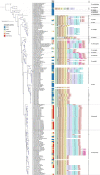Genetic Organization of the aprX-lipA2 Operon Affects the Proteolytic Potential of Pseudomonas Species in Milk
- PMID: 32587583
- PMCID: PMC7298200
- DOI: 10.3389/fmicb.2020.01190
Genetic Organization of the aprX-lipA2 Operon Affects the Proteolytic Potential of Pseudomonas Species in Milk
Abstract
Psychrotolerant Pseudomonas species are a main cause of proteolytic spoilage of ultra-high temperature (UHT) milk products due to the secretion of the heat-resistant metallopeptidase AprX, which is encoded by the first gene of the aprX-lipA2 operon. While the proteolytic property has been characterized for many different Pseudomonas isolates, the underlying aprX-lipA2 gene organization was only described for a few strains so far. In this study, the phylogenomic analysis of 185 Pseudomonas type strains revealed that the presence of aprX is strongly associated to a monophylum composed of 81 species, of which 83% carried the aprX locus. Furthermore, almost all type strains of known milk-relevant species were shown to be members of the three monophyletic groups P. fluorescens, P. gessardii, and P. fragi. In total, 22 different types of aprX-lipA2 genetic organizations were identified in the genus, whereby 31% of the species tested carried the type 1 operon structure consisting of eight genes (aprXIDEF prtAB lipA2). Other genetic structures differed from type 1 mainly in the presence and location of genes coding for two lipases (lipA1 and lipA2) and putative autotransporters (prtA and prtB). The peptidase activity of 129 strains, as determined on skim milk agar and in UHT-milk, correlated largely with different aprX-lipA2 gene compositions. Particularly, isolates harboring the type 1 operon were highly proteolytic, while strains with other operon types, especially ones lacking prtA and prtB, exhibited significantly lower peptidase activities. In conclusion, the phylogenomic position and the aprX-lipA2 gene organization specify the proteolytic potential of Pseudomonas isolates. In addition, however, an interplay of several environmental factors and intrinsic traits influences production and activity of AprX, leading to strain-specific proteolytic phenotypes.
Keywords: AprX peptidase; aprX-lipA2 operon; genus Pseudomonas; milk spoilage; proteolytic potential.
Copyright © 2020 Maier, Huptas, von Neubeck, Scherer, Wenning and Lücking.
Figures





Similar articles
-
Simultaneous quantification of the most common and proteolytic Pseudomonas species in raw milk by multiplex qPCR.Appl Microbiol Biotechnol. 2021 Feb;105(4):1693-1708. doi: 10.1007/s00253-021-11109-0. Epub 2021 Feb 1. Appl Microbiol Biotechnol. 2021. PMID: 33527148 Free PMC article.
-
Proteolytic activity and heat resistance of the protease AprX from Pseudomonas in relation to genotypic characteristics.Int J Food Microbiol. 2023 Apr 16;391-393:110147. doi: 10.1016/j.ijfoodmicro.2023.110147. Epub 2023 Feb 23. Int J Food Microbiol. 2023. PMID: 36848797
-
Heterogeneity of heat-resistant proteases from milk Pseudomonas species.Int J Food Microbiol. 2009 Jul 31;133(1-2):68-77. doi: 10.1016/j.ijfoodmicro.2009.04.027. Epub 2009 May 6. Int J Food Microbiol. 2009. PMID: 19481283
-
The Extracellular Protease AprX from Pseudomonas and its Spoilage Potential for UHT Milk: A Review.Compr Rev Food Sci Food Saf. 2019 Jul;18(4):834-852. doi: 10.1111/1541-4337.12452. Epub 2019 May 10. Compr Rev Food Sci Food Saf. 2019. PMID: 33336988
-
The Biodiversity of the Microbiota Producing Heat-Resistant Enzymes Responsible for Spoilage in Processed Bovine Milk and Dairy Products.Front Microbiol. 2017 Mar 1;8:302. doi: 10.3389/fmicb.2017.00302. eCollection 2017. Front Microbiol. 2017. PMID: 28298906 Free PMC article. Review.
Cited by
-
Pseudomonas donghuensis HYS gtrA/B/II Gene Cluster Contributes to Its Pathogenicity toward Caenorhabditis elegans.Int J Mol Sci. 2021 Oct 4;22(19):10741. doi: 10.3390/ijms221910741. Int J Mol Sci. 2021. PMID: 34639082 Free PMC article.
-
Simultaneous quantification of the most common and proteolytic Pseudomonas species in raw milk by multiplex qPCR.Appl Microbiol Biotechnol. 2021 Feb;105(4):1693-1708. doi: 10.1007/s00253-021-11109-0. Epub 2021 Feb 1. Appl Microbiol Biotechnol. 2021. PMID: 33527148 Free PMC article.
-
Experimental and Computational Insights into Polyurethane Plastic Waste Conversion to Microbial Bioplastic.Curr Microbiol. 2025 Apr 3;82(5):227. doi: 10.1007/s00284-025-04218-w. Curr Microbiol. 2025. PMID: 40178692
-
Spatial transcriptomic and single-nucleus analysis reveals heterogeneity in a gigantic single-celled syncytium.Elife. 2022 Feb 23;11:e69745. doi: 10.7554/eLife.69745. Elife. 2022. PMID: 35195068 Free PMC article.
-
Divergent endophytic viromes and phage genome repertoires among banana (Musa) species.Front Microbiol. 2023 Jun 9;14:1127606. doi: 10.3389/fmicb.2023.1127606. eCollection 2023. Front Microbiol. 2023. PMID: 37362937 Free PMC article.
References
-
- Arnold J. B. (2019). ggthemes: extra themes, scales and geoms for ‘ggplot2’ [Online]. Available at: https://CRAN.R-project.org/package=ggthemes (Accessed March 19, 2020).
-
- Auguie B. (2017). gridExtra: miscellaneous functions for "Grid" graphics [Online]. Available at: https://CRAN.R-project.org/package=gridExtra (Accessed March 19, 2020).
-
- Baur C., Krewinkel M., Kutzli I., Kranz B., von Neubeck M., Huptas C., et al. (2015b). Isolation and characterisation of a heat-resistant peptidase from Pseudomonas panacis withstanding general UHT processes. Int. Dairy J. 49, 46–55. 10.1016/j.idairyj.2015.04.009 - DOI
LinkOut - more resources
Full Text Sources
Other Literature Sources

